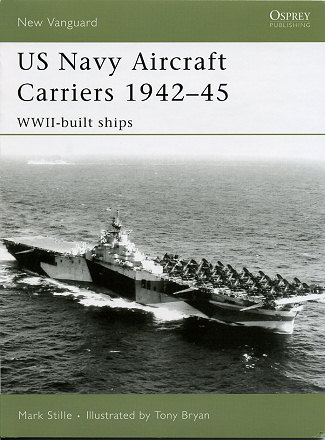 Another
in their excellent New Vanguard series is this book on WWII build US Aircraft
Carriers. This basically means the Essex and Independence class of fleet and
light carriers. The Navy didn't want the light carriers, built on Cleveland
Class cruiser hulls, but President Roosevelt was insistent on it and they were
developed.
Another
in their excellent New Vanguard series is this book on WWII build US Aircraft
Carriers. This basically means the Essex and Independence class of fleet and
light carriers. The Navy didn't want the light carriers, built on Cleveland
Class cruiser hulls, but President Roosevelt was insistent on it and they were
developed.
But let's start with the Essex class of fleet carriers. These
were built to carry nearly 100 aircraft, and after the losses of 1942, were
sorely needed to stem the tide of Japanese conquest and push them back. It is
fortuitous that the need was seen prior to the start of hostilities as these
ships were not quickly built.
Essex was ordered in 1938 and with war underway in Europe,
the total ordered was 26 all but two were completed. 17 were finished
before the end of the war and 14 of those seeing action, making it the largest
class of aircraft carrier ever built.
The other class of carrier used was the Independence class.
Of the 9 completed, five of them were converted from already started ships and
four were built as such from keel up. All saw action and several of them were
used post-war by foreign navies. The last of them, the Deldalo, ex-Cabot was
unfortunately scrapped in 2000 despite efforts to save her as a museum ship,
representing the only Independence class carrier around. Thanks to that
short-sightedness, there are none of these ships left.
The book covers not only the basic construction of each ship
and the various weapons that it carried, but also the complements of their air
groups, which changed as the war evolved. A short history of each ship and its
eventual fate are also provided. I found it interesting that only four Essex
class ships were saved as museums: Yorktown CV-10, is at Charleston; Intrepid
CV-11 is in New York City, Hornet CV-12 is at Alameda, and Lexington CV-16 is at
Corpus Christi.
The superlative images in the book are further enhanced by
the artwork of Tony Bryan who shows a number of these ships in the seemingly
bewildering array of camouflage schemes worn by these ships.
This is a book that ship fans will just have to have in their
libraries and the rest of us will find it an excellent primer on the types.
February 2007
For more on the complete line of Osprey books,
visit www.ospreypublishing.com. In the US, it is
Osprey Direct at 44-02 23rd St, Suite 219, Long Island City, NY 11101., where you can
get a catalogue of available books.
If you would like your product reviewed fairly and quickly by a
site that has nearly 350,000 visitors a month, please contact
me or see other details in the Note to
Contributors.
 Another
in their excellent New Vanguard series is this book on WWII build US Aircraft
Carriers. This basically means the Essex and Independence class of fleet and
light carriers. The Navy didn't want the light carriers, built on Cleveland
Class cruiser hulls, but President Roosevelt was insistent on it and they were
developed.
Another
in their excellent New Vanguard series is this book on WWII build US Aircraft
Carriers. This basically means the Essex and Independence class of fleet and
light carriers. The Navy didn't want the light carriers, built on Cleveland
Class cruiser hulls, but President Roosevelt was insistent on it and they were
developed.